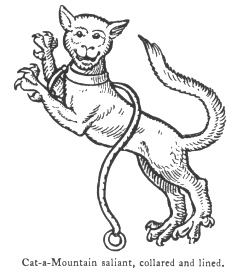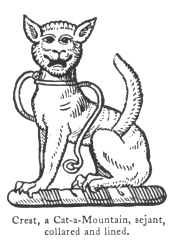
Masonic, Occult and Esoteric Online Library
Fictitious and Symbolic Creatures in Art
By John Vinycomb
Other Chimerical Creatures and Heraldic Beasts- Cat-a-Mountain—Tiger Cat or Wild Cat

The Clan Chattan, who gave their name to the county of Caithness, bore as their cognisance the wild mountain cat, and called their chieftain, the Earl of Sutherland, "Mohr an chat" (The Great Wild Cat). The Mackintoshes still bear as their crests and supporters these ferocious cats, with the appropriate warning as a motto, "Touch not the cat but a glove."
The whole is a pun upon the word "Catti," the Teutonic settlers of Caithness, i.e., Catti-ness, and means "Touch not the Clan Cattan (or mountain cat) without a glove." Here "but" is used in the
original meaning, beout, i.e., without. For another example of "but" meaning without, see Amos iii. 7. The same words are also used as the motto of several Scottish families.
None will forget how the cat-a-mountain showed her claws to the Clan Kay, in the Wynds of Perth in Sir Walter Scott's "Fair Maid of Perth."
The Heraldic Musion.—Bossewell, in his work on 
heraldry published 1572, describes a musion as "a beaste that is enimie to myse and rattes." He adds also that he is "slye and wittie, and seeth so sharply, that he overcommeth darkness of the nighte by the shyninge lighte of his eyne. In the shape of body, he is like unto a leoparde, and hath a greate mouthe. He doth delighte that he enjoyeth his libertie, and in his youthe he is swifte, plyante, and merrie. He maketh a rufull noyse, and a gastefull when he proffereth to fighte with another. He is a cruel beaste when he is wilde and falleth on his owne feet from moste high places, and uneth (scarce) is hurte therewith. When he hathe a fayre skinne, he is, as it were, prowde thereof, and then he goeth fast aboute to be seene."
Childebert, King of France, in token of his having taken captive Gondomar of Bourgogne, assumed the device of a tiger-cat or ounce behind a grating or troillis, gules cloué argent. This recalls the famous scene between Sanglier Rouge and Toison d’Or in "Quentin Durward," when Charles the Bold's jester professes to help the unhappy envoy of De la Marck by describing it as a cat looking out of a dairy window.
The cat, though domesticated, is considered as possessed of ingratitude; in its friendship so uncertain and so vicious in its nature, "that," say old writers, "it is only calculated for destroying the obnoxious race of rats and other small game."
From the mediæval superstition that Satan's favourite form was a black cat, it was superstitiously called "a familiar." Hence witches were said to have a cat as their familiar.
The Cat: A symbol of liberty.—The Roman goddess of Liberty was represented as holding a cup in one hand, a broken sceptre in the other, and a cat lying at her feet. No animal is so great an enemy to all constraint as a cat.
The cat was held in veneration by the Egyptians as sacred to the goddess Bubastis. This deity is represented with a human body and a cat's head. Diodorus tells us that whoever killed a cat, even by accident, was by the Egyptians punished with death. According to Egyptian tradition, Diana assumed the form of a cat, and thus excited the fury of the giants. The London Review says: "The Egyptians worshipped the cat as a symbol of the moon, not only because it is more active after sunset, but from the dilation and contraction of its orb, symbolical of the waxing and waning of the night goddess."
In heraldry it should always be represented full-faced like the leopard.
Erminois three cats-a-mountain passant gardant, in pale azure, each charged on the body with an ermine spot or. Crest: a demi cat-a-mountain gardant, azure, gorged with a collar gemel, and charged with ermine spots, two and one.—Tibbets.
The supporters of the Earl of Clanricarde are wild cats, and also those of the Earl of Belmore. It is the crest of De Burgh.
"ÆNEAS.—His mantle was the lion's,
With all its tawny bars,
His falchion, like Orion's,
Was gemmed with golden stars.
Upon his lofty helmet
A brazen terror rode;
No sword could overwhelm it
When in the fight it glowed.
For like a wild cat brindled,
It spat with eyes on fire,
And in the battle kindled
Immortal rage and ire,
Now in the sunshine sleeping,
How gently it reposed;
But still in wisdom keeping
A single eye unclosed."
Queen Dido, by T. S.
